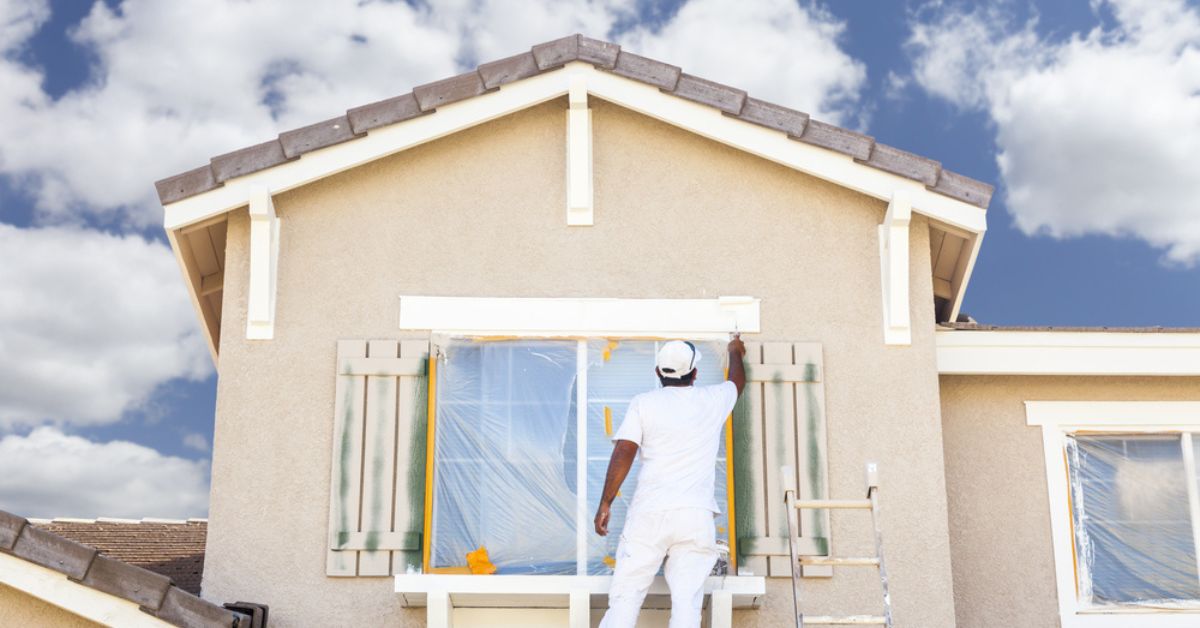You’ve bought a whole gallon to paint the interior of your house. Surprisingly, some of it is left, giving you all guilty looks for not utilizing it completely. You want to use it now and apply it to the exterior of your house.
The colors you use that are unsuitable for your house’s exterior can cause some damage.
In fact, they may not only look terrible, but in rare situations, they may also cause structural harm.
We know what happens when people use the wrong paint type for a specific area if you are one of those people who has done that. Not to worry! We are here to guide you on whether can you use interior paint outside or not. Keep reading to discover the optimal paint solutions that cater to your requirements.
Understanding the Differences
In recent years, there has been a notable change in the chemistry of interior and exterior paints. Paints are designed to be utilized in defined areas alone. It’s not as simple as spraying old colors on any old surface. Modern colors are made to provide a more dependable surface in specific conditions.
Paints can be broadly categorized into two categories. It is a debate between exterior vs interior paint, oil-based and water-based paints (including vinyl soft sheen paints). It would be easy if there were two distinct types of paint—one for internal use and the other for exterior use. However, there are compositions for both kinds that are appropriate for both surfaces.
Oil-based paints are more able to resist dirt when used as exterior paints. On exterior surfaces, however, water-based latex paint is also frequently utilized. This is because water-based latex paint is more advantageous and just as durable.
Myth vs. Reality: Debunking the Common Beliefs
Let’s debunk the myths surrounding the use of interior paint for exterior surfaces. Many people believe it’s possible, but let’s uncover the reality and potential consequences of whether can you use indoor paint outside or not:
Myth: Interior paint can be used outside without any results.
Reality: Using interior paint outdoors can lead to various issues and drawbacks that should not be ignored.
Myth: Interior paint is durable enough to withstand outdoor conditions.
Reality: Interior paint lacks the properties to withstand weather elements. When exposed to sunlight, rain, or humidity, it can lead to premature peeling, fading, and cracking.
Myth: There is no need to invest in exterior paint when interior paint is readily available.
Reality: Exterior paint is designed to endure outdoor conditions, offering superior protection against moisture, UV rays, and temperature fluctuations.
Myth: Proper surface preparation is unnecessary when using interior paint outside.
Reality: The application of interior paint to exterior surfaces can be compromised by improper surface preparation, resulting in poor outcomes and early failure.
Myth: Adding a topcoat can make interior paint suitable for outdoor use.
Reality: While a topcoat may provide temporary protection, it is not a substitute for using proper exterior paint designed to withstand outdoor conditions.
Myth: Interior paint is cost-effective for outdoor projects.
Reality: In the long run, using interior paint outside can prove to be more costly due to the need for frequent repainting and repairs.
Myth: Interior paint provides the same aesthetic appeal as exterior paint.
Reality: Exterior paint offers a broader range of colors and finishes specifically designed to enhance the appearance of outdoor surfaces.
Factors to Consider – Can Interior Paint Be Used Outside?
Contact with the Elements
Surfaces outside are constantly exposed to elements like sunlight, rain, wind, and changing temperatures. However, interior paint is specifically designed to maintain the same specific environment. endure controlled inside environments. As a result, it might not offer the necessary defense against the forces of nature.
Lifespan and Resilience
More robust binders and chemicals create exterior paints to strengthen against weather resistance. Interior colors lack these components, which, when used outdoors, can cause rapid peeling, fading, and general degradation.
Mold and Mildew Resistance
Anti-microbial compounds are frequently used in the formulation of exterior paints to prevent the growth of mold and mildew. Interior paint might not have these characteristics, making it vulnerable to problems in outdoor conditions.
Color Fading
Exterior use of interior paint colors can cause them to fade quickly due to intense UV exposure. The vivid hues you enjoy inside could become dull and lifeless with time.
Tips for Using Interior Paint in Outdoor Projects
While it’s generally recommended to use exterior paint for outdoor projects, there may be certain circumstances where using interior color becomes necessary. Here are some tips to consider if you must use interior paint for your outdoor project:
Check the Weather Conditions
Choose when the weather forecast predicts several consecutive days of dry weather with mild temperatures. Avoid painting during extreme heat, cold, or high humidity, as these conditions can negatively impact the paint’s drying and adhesion.
Surface Preparation
Clean and prepare the surface thoroughly before applying the interior paint. Remove dirt, dust, loose paint, and any other debris. Consider using a primer designed for exterior surfaces to improve adhesion and durability.
Select High-Quality Paint
Opt for the highest quality interior paint available, preferably one with mildew and moisture-resistant properties. This can provide some protection against outdoor elements, although it won’t be as effective as the proper exterior tint.
Consult with Professionals
If you’re unsure about using interior pigment for your outdoor project or need further guidance, consult with professionals from any exterior painting company like Better Roofing and Remodeling. They can provide expert advice based on your needs and recommend alternative solutions if necessary.
Pro Tip: While using interior paint for outdoor projects is not ideal, following these tips can help mitigate potential risks and challenges. However, it’s important to remember that the longevity and performance of interior paint outdoors will still be compromised compared to using proper exterior paint.
Final Thoughts
The practice of using interior paint outside is not recommended. It’s crucial to prioritize using colors specifically designed for external applications. These paints are formulated with additives and properties that enable them to withstand harsh outdoor elements and provide superior protection. Remember to learn the steps to clean the walls before painting to ensure that your walls are shining like a diamond.
By choosing the right exterior paint, you can ensure that your outdoor surfaces remain vibrant, protected, and structurally sound for an extended period. Now you have a better knowledge of interior paint, the meaning of “interior,” and the effects of using it outside.
Please share this information if you find it informative or helpful.
FAQs
What happens if you use interior paint outside?
The chemical components in interior paints differ from those in exterior colors. For instance, they won’t be resilient to weather’s effects. Rain, frost, and other types of bad weather can cause various problems, such as cracking or splitting paint.
Can I use exterior paint inside?
Given its durability and resistance to fading, outdoor color may appear intriguing. However, because of the dangerous chemicals that may be discharged into the air, it is not advised to apply exterior paint inside your home.
What should I do if I’ve already painted the exterior with inside paint?
If you’ve already use interior paint outside and are experiencing issues, it is recommended to remove the interior color and apply the appropriate exterior paint. Consulting with professionals or paint experts can guide the best course of action for your specific situation.
Are there any health concerns associated with using interior paint outside?
Interior paint may contain volatile organic compounds (VOCs) that can be released into the air. When used outdoors with less ventilation, it may pose potential health risks. Opting for exterior paints with low VOC content can minimize these concerns.
How to make interior paint into exterior paint?
It is not recommended to try to convert interior paint into exterior paint. If you need to paint exterior surfaces, purchasing and using paint specifically formulated for external use is best.






